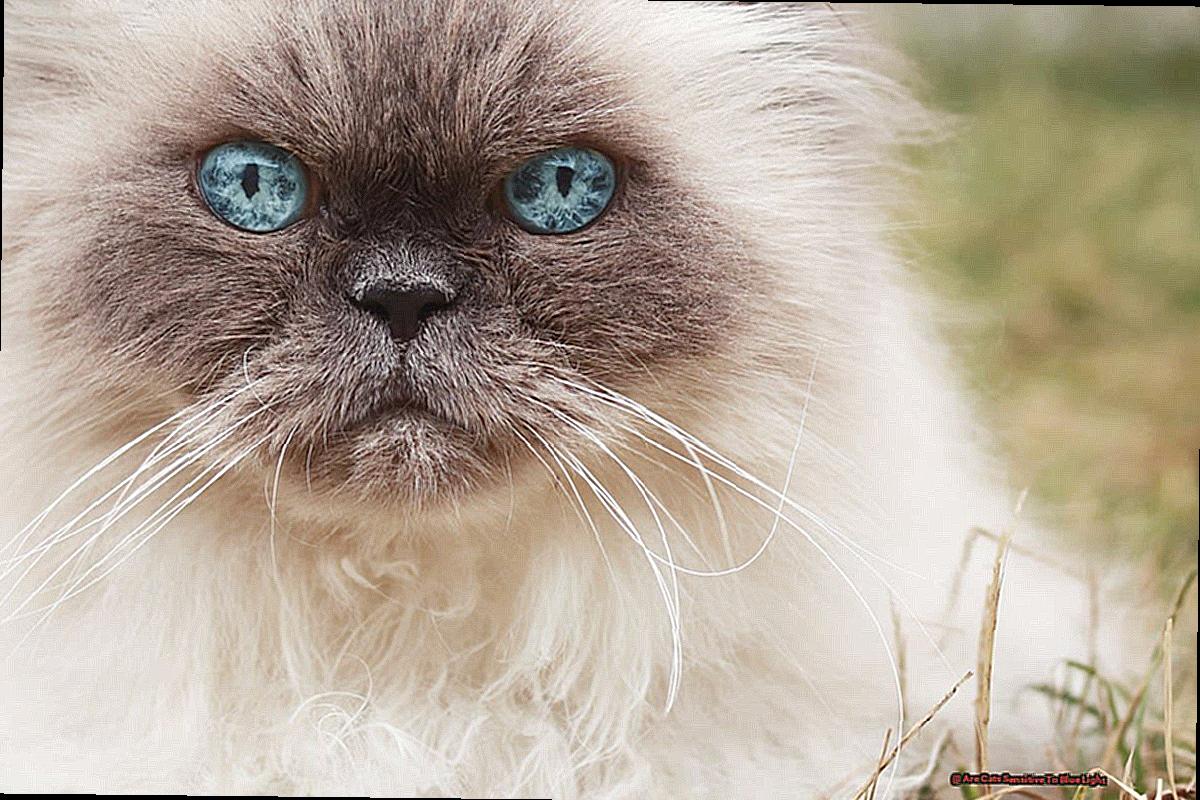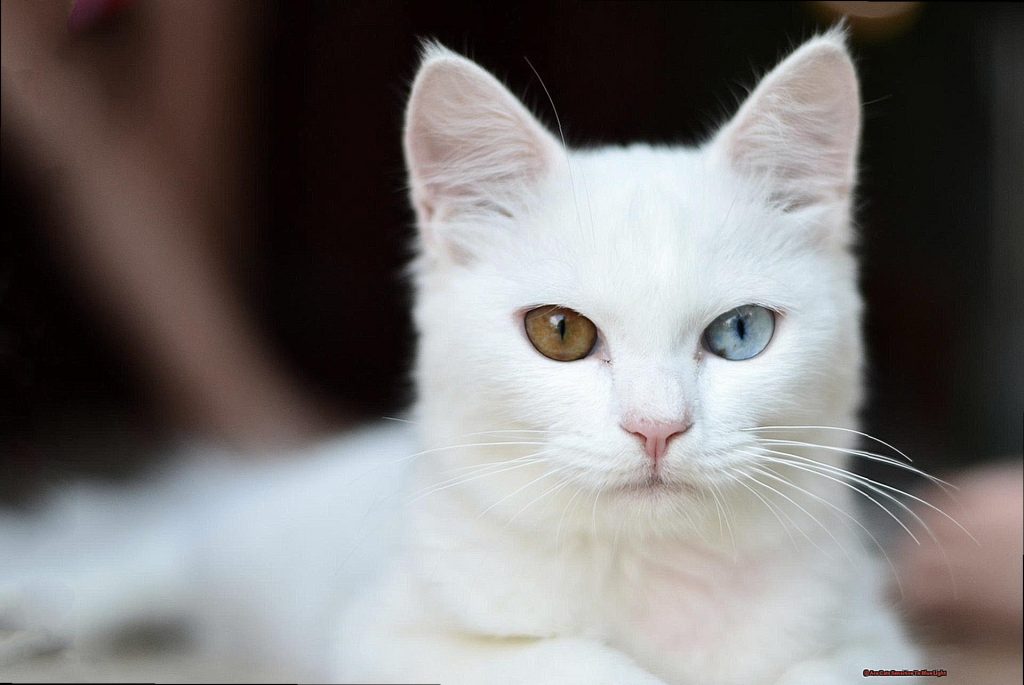As cat owners, we know that our furry companions are always on the lookout for the next laser pointer or elusive bug to pounce on.
But what about their sensitivity to a different kind of light? While we may associate blue light with screens and energy-efficient bulbs, cats actually have a unique reaction to this type of light.
It can impact their behavior, sleep patterns, and overall well-being. So before you turn on that late-night Netflix binge session, let’s dive into the fascinating world of cats and blue light sensitivity.
So, grab your favorite beverage (and maybe some catnip for your furry friend) and let’s shed some light on this intriguing topic together.
Are Cats Sensitive To Blue Light?
Contents
Yes, we’re talking about blue light. While humans are known to be affected by this type of light, its effects on cats are still being studied. As an expert on the topic, I’m here to share some valuable insights and tips for pet owners to minimize their cat’s exposure to blue light.
First, let’s understand what blue light is and why it has become a concern in recent years. Blue light is a high-energy visible light (HEV) that is emitted from various sources such as the sun, electronic devices, and energy-efficient light bulbs. It has a shorter wavelength and higher frequency compared to other colors in the visible light spectrum. This type of light has been linked to potential health concerns for humans, such as disrupted sleep patterns and eye strain.
Now, let’s dive into the anatomy of a cat’s eye. Cats have a layer of reflective cells called the tapetum lucidum, which helps them see better in low light conditions. However, this may also make them more sensitive to certain types of light, including blue light.
Limited studies have been conducted on cats and blue light sensitivity, but some research suggests that it can have negative effects on their health. One study found that exposure to blue light can cause retinal damage in cats. Another study found that cats with certain eye conditions, such as glaucoma, were more sensitive to blue light.
So what does this mean for your beloved feline friends? If cats are indeed sensitive to blue light, it could potentially lead to disrupted sleep patterns, eye strain, and even retinal damage. As responsible pet owners, it’s important for us to take precautions to protect our furry companions.
Here are some tips to minimize your cat’s exposure to blue light:
- Limit screen time: Just like humans, cats can be attracted to moving images and bright colors on electronic devices. Try to limit their screen time to reduce their exposure to blue light.
- Choose warm-colored lights: Consider switching to warm white or amber-colored lights for your home. These colors have a lower blue light emission compared to cool white lights.
- Invest in blue light blocking glasses for your cat: Yes, they do exist. These glasses filter out blue light and can help protect your cat’s eyes from potential damage.
Blue Light and Its Effects on Cats’ Retinas: What You Need to Know
Cats’ eyes are very different from humans’ eyes. They have a larger pupil, which allows more light to enter, and a reflective layer behind their retina called the tapetum lucidum, which enhances their night vision.
Blue light, with its short wavelength and high energy, is found in natural sunlight but is also emitted from electronic devices such as smartphones, laptops, and LED lights. And just like how it affects us, too much exposure to blue light can also harm our cats’ eyes.
The tapetum lucidum in cats’ eyes reflects blue light, making it easier for them to see in low light conditions. However, this also means that they are more sensitive to blue light and can be easily overstimulated by it. This can lead to eye strain, fatigue, and even damage to the retina if exposed to high levels for extended periods. Cats may not see blue colors as vividly as we do, but they are still vulnerable to its negative effects.
Moreover, research has shown that excessive exposure to blue light can disrupt cats’ sleep patterns, just like it does to humans. This can result in sleep deprivation and other health issues for our feline friends. So what can we do as responsible pet owners to protect our cats from too much blue light?
Firstly, limit their exposure to electronic devices. Cats who spend a lot of time indoors and are exposed to artificial blue light from screens are at a higher risk of experiencing these negative effects. Consider setting designated screen-free times or areas in your home where your cat can relax without being exposed to blue light.
Secondly, invest in blue light filters for your devices. These filters can reduce the amount of blue light emitted from screens and protect your cat’s eyes while they are snuggled up next to you.
And lastly, make sure your cat gets enough natural light during the day. This will help regulate their circadian rhythm and improve their sleep patterns, reducing the negative effects of artificial blue light at night.
Potential Health Concerns for Cats Exposed to Blue Light
As cat owners, we often go above and beyond to ensure the well-being of our furry companions. We make sure they have a healthy diet, plenty of toys to play with, and a cozy place to sleep. However, there is one potential health concern for cats that often goes unnoticed – exposure to blue light.
You may be wondering, “What is blue light, and how can it affect my cat?” Well, blue light is a type of light with a short wavelength and high energy. It is commonly emitted from electronic devices such as smartphones, computers, and televisions.
While it can be beneficial for humans by regulating our circadian rhythm and boosting our mood, cats have a unique visual system that makes them more sensitive to this type of light.
Disruption of Sleep Patterns
Just like humans, cats have an internal clock that tells them when to feel awake or sleepy. However, unlike us, cats are crepuscular animals, meaning they are most active at dawn and dusk. Exposing them to blue light at night can confuse their internal clock and disrupt their sleep patterns. This can lead to insomnia and other sleep-related issues, making it challenging for your cat to get the rest they need.
Eye Strain and Fatigue
Cats have a higher sensitivity to blue light than humans because their eyes are not equipped with enough protective pigments. Prolonged exposure to blue light can cause eye fatigue and strain in cats, leading to symptoms like dry eyes, headaches, and blurred vision. In severe cases, it may even lead to retinal damage and vision loss.
Potential Eye Conditions
Research has shown that blue light exposure can contribute to the development of certain eye conditions in cats, such as cataracts and age-related macular degeneration (AMD). These conditions can lead to vision loss if left untreated, making it crucial to limit a cat’s exposure to blue light.
Behavioral Changes
Cats are most active at dawn and dusk, but blue light exposure at night can cause them to become more active and restless. This can disrupt their natural sleep-wake cycle, leading to changes in behavior such as increased aggression, hyperactivity, and irritability.
The Role of Circadian Rhythm in Cats’ Sleep Patterns and How Blue Light Disrupts It
Cats, just like humans, have a natural sleep-wake cycle known as the circadian rhythm. This internal body clock is regulated by the production and release of hormones, such as melatonin, which helps induce sleepiness. A well-regulated circadian rhythm is crucial for cats’ overall health and well-being as it allows them to get the necessary rest they need to stay alert and active during the day.
How Blue Light Disrupts Cats’ Circadian Rhythm
Blue light, which is emitted from electronic devices and artificial lighting, can disrupt this natural rhythm in both humans and cats. It suppresses the production of melatonin, making it harder for cats to fall asleep and stay asleep. This is because blue light mimics the natural light of the sun, tricking the brain into thinking it’s still daytime and inhibiting the release of melatonin.
Why Cats are More Susceptible to Blue Light
Studies have shown that cats are more sensitive to blue light than humans due to their unique retinal structure. Cats have a higher concentration of light-sensitive cells called rods, which are more responsive to blue light. This increased sensitivity can lead to sleep disturbances in cats, causing them to be less rested and more irritable during the day.
The Negative Effects of Blue Light on Cats’ Health and Behavior
Disrupted circadian rhythm caused by blue light can have negative effects on cats’ overall health and behavior. Cats who are exposed to blue light for prolonged periods may experience sleep disturbances, leading to fatigue, irritability, and even weight gain. It can also affect their behavior, causing them to be more aggressive or anxious.
Subheading: Practical Solutions for Cat Owners to Minimize Blue Light Exposure
As a cat owner, it’s important to be aware of your feline friend’s sensitivity to blue light and take steps to minimize their exposure, especially during the evening and night when they are most active. Here are some practical solutions you can implement:
Sources of Blue Light Exposure for Cats: Identifying the Risks
The wavelength of blue light is shorter than that of other visible light types, and it has more energy. This light comes from both natural and man-made sources, like LED lights, computer screens, and smartphones. We people are becoming more and more aware of the possible risks of blue light exposure. Cat owners should also know how it can affect their cats.
Natural sunshine is the main source of blue light for cats, since they spend a lot of time near windows or outside. Blue light from electronics like TVs and computers is also becoming more common because people use technology and artificial lighting in their homes more. Blue light exposure for cats relies on many things, like how much time they spend outside, how old they are, and the type of lighting in their area.
Since kittens and younger cats’ eyes are still growing, they are more sensitive to blue light. They can’t fully block out dangerous blue light rays yet. Cats that have certain eye problems, like cataracts or macular degeneration, may also be more likely to get sick from blue light. What do these results really mean?
Too much blue light can make cats’ eyes hurt, give them headaches, and mess up their sleep habits. This is because blue light can stop the production of melatonin, a hormone that helps cats sleep and wake up at the right times. Cats need good sleep for their health and well-being, just like people do. Long-term exposure to blue light can also hurt the retina and raise the risk of getting eye diseases like macular degeneration.
It’s important for cat owners to know where blue light is coming from in their homes and take the right steps to protect their cats from the possible risks of blue light. Some easy things we can do are limit our cats’ and our own computer time, use warm-colored lights at night, and make sure our cats have a safe place to sleep that isn’t near any electronics.
Minimizing Blue Light Exposure for Cats: Tips and Recommendations from Experts
We feed them good food and take them to the vet regularly to make sure they stay healthy and happy. But have you ever thought about how blue light might affect your cat’s health? That’s right, blue light.
Electronic devices like smartphones, computers, and TVs give off blue light. Nature’s sunlight also has it. For people, studies have shown that too much blue light can be bad, but researchers are still looking into how it affects cats.
What does blue light mean, and how does it affect cats? We’re going to learn about blue light and look at what experts say you can do to protect your cat’s health by limiting its exposure.
First, let’s look at how blue light works scientifically. Compared to other types of light, blue light has a shorter range and more energy. In this way, it becomes stronger and might be bad for our eyes. There is something about cats’ bodies that makes them more sensitive to blue light than people. Being able to see well in low light makes their eyes more vulnerable to its affects.
Concerns about cats’ exposure to blue light include how it might affect their circadian rhythm, which is their body’s normal sleep-wake routine. Cats need between 12 and 16 hours of sleep every day, and their bodies use natural light to control when they sleep. Blue light at night can mess up this cycle by stopping the production of melatonin, a hormone that helps you fall asleep. This can make it hard to sleep and cause other health problems, like diabetes, fat, and changes in mood.
Not to worry, though; there are easy things you can do to keep your cat from being too close to blue light. First, limit how much time they spend in front of a computer. In fact, cats can be very interested in things that move or have bright colors, like those on electronics. It’s best to keep them away from TVs, computers, and tablets at night.
Putting blue light screens on your own devices is another way to keep your cat’s eyes safe. These screens not only keep your eyes safe, but they also cut down on the blue light that might be bouncing off of things and hurting your pets. You might also want to buy home lighting that looks like natural sunlight and doesn’t give off dangerous blue light.

Lastly, make sure your cat has a lot of natural light during the day. This will help keep their circadian cycle in check and lessen the effects of blue light at night.
Common Misconceptions About Cats and Blue Light Sensitivity: Debunking the Myths
As much as we may believe that our cats are unaffected by this type of light, recent studies have shown otherwise. It’s time to debunk some common misconceptions about cats and blue light sensitivity and learn how to protect your furry companion’s health.
Myth #1: Cats cannot see blue light at all.
It’s true that cats’ eyes are not designed to see the same range of colors as humans. However, they do have some level of blue light perception. This means that they can see shades of blue, but not as vividly as we do. So next time your kitty is staring intently at a blue object, remember that they can actually see it.
Myth #2: Cats are not affected by artificial blue light from electronic devices.
As crepuscular animals, cats are mainly active during dawn and dusk, so it may seem like they are not affected by artificial blue light from electronic devices. However, just like humans, their eyes can be fatigued and strained by prolonged exposure to bright blue light. This can lead to discomfort and potential long-term effects on their vision. So the next time you’re binge-watching your favorite show on your laptop, consider taking a break and giving your cat a chance to rest their eyes.
Myth #3: All types of blue light are harmful to cats.
While it’s true that excessive exposure to blue light from the sun can be harmful to cats, not all artificial blue light is bad for them. In fact, some studies have shown that certain wavelengths of blue light can actually be beneficial for their overall well-being. These include promoting better sleep patterns and aiding in cognitive function.
Myth #4: Only older cats are sensitive to blue light.
Don’t let your cat’s youthful energy fool you – all cats, regardless of age, have some level of sensitivity to blue light. This is because their eyes contain specialized cells called rods and cones, which are responsible for detecting different wavelengths of light. So whether your cat is a playful kitten or a wise senior, it’s important to protect their eyes from blue light exposure.
Conclusion
In conclusion, it is clear that cats are indeed sensitive to blue light.
This sensitivity can have both positive and negative effects on their behavior and health. By understanding this aspect of their biology, we can better care for our feline friends and create a more comfortable environment for them.
So let’s keep our furry companions in mind when considering the impact of blue light on our daily lives.






